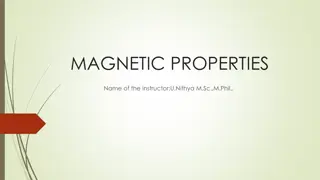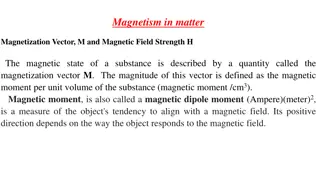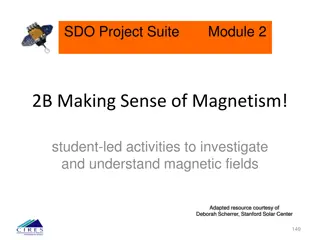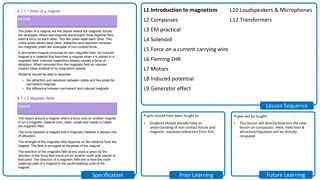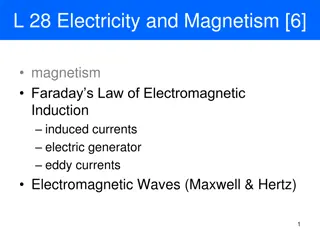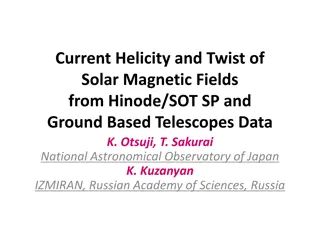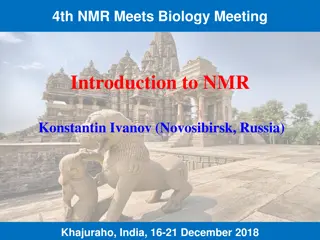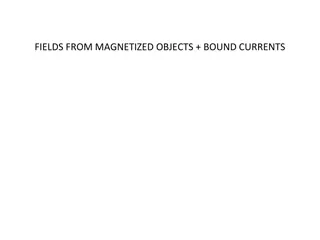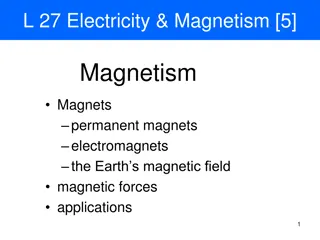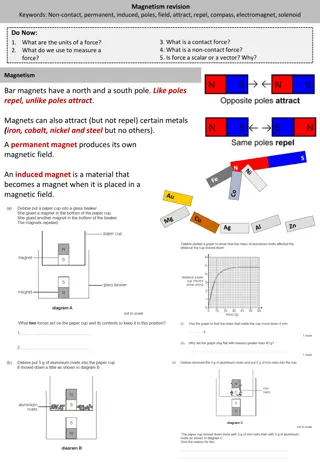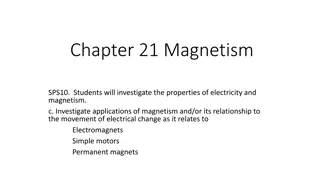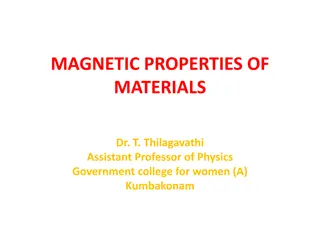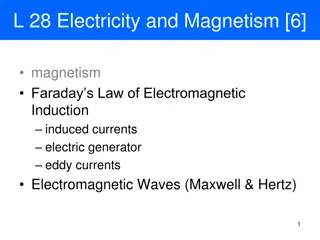Exploring Magnetic Fields and Earth's Magnetism
Uncover the fascinating world of magnetic fields, from the historical discoveries of magnetism to understanding the Earth's magnetic field and its poles. Dive into the concepts of magnetic forces, field lines, and the direction of Earth's magnetic field over time. Discover the properties of magnetic fields and their effects on charged particles moving within them.
Download Presentation

Please find below an Image/Link to download the presentation.
The content on the website is provided AS IS for your information and personal use only. It may not be sold, licensed, or shared on other websites without obtaining consent from the author. Download presentation by click this link. If you encounter any issues during the download, it is possible that the publisher has removed the file from their server.
E N D
Presentation Transcript
Magnetic Fields Chapter 29
History of Magnetism In 1269, Pierre de Maricourt of France found that the directions of a needle near a spherical natural magnet formed lines that encircled the sphere and passed through two points diametrically opposite each other, which he called the poles of the magnet. Subsequent experiments showed that every magnet, regardless of its shape, has two poles, called North (N) and (S) poles, that exert forces on other magnetic poles similar to the way electric charges exert forces on one another. That is, like poles (N-N or S-S) repel each other, and opposite poles (N-S) attract each other
Magnetic Fields and Forces In our study of electricity, we described the interactions between charged objects in terms of electric fields. Recall that an electric field surrounds any electric charge. In addition to containing an electric field, the region of space surrounding any moving electric charge also contains a magnetic field.
Earths Magnetic Field Lines and Poles
Earths Poles When we speak of a compass magnet having a north pole and a south pole, it is more proper to say that it has a north seeking pole and a south seeking pole. This wording means that the north seeking pole points to the north geographic pole of the Earth, whereas the south seeking pole points to the south geographic pole.
Direction of the Earths Magnetic Field The direction of the Earth s magnetic field has reversed several times during the last million years. Evidence for this reversal is provided by basalt, a type of rock on the ocean floor. As the lava cools, it solidifies and retains a picture of the Earth s magnetic field direction
Magnetic Field We can define a magnetic field, B, at some point in space in terms of the magnetic force, F, the field exerts on a charged particle moving with a velocity v, which we call the test object. For the time being, let s assume no electric or gravitational fields are present at the location of the test object. Experiments on various charged particles moving in a magnetic field give the following results.
Properties of the magnetic force on a charged particle moving in a magnetic field The magnetic F of the magnetic force exerted on the particle is proportional to the charge q and to the speed v of the particle. When a charged particle moves parallel to the magnetic field vector, the magnetic force acting on the particle is zero When the particles velocity vector makes any angle 0 with the magnetic field, the magnetic force acts in a direction perpendicular to both v and B; that is, F is perpendicular to the plane formed by v and B.
Properties of the Magnetic Force Continued The magnetic force exerted on a positive charge is in the direction opposite the direction of the magnetic force exerted on a negative charge moving in the same direction. The magnitude of the magnetic force exerted on the moving particle is proportional to sin theta, where theta is the angle the particle s velocity vector makes with the direction of B.
Vector Expression for the Magnetic Force on a Charged Particle moving in a magnetic field
Magnitude of the magnetic force on a charged particle moving in a magnetic field.
SI Unit of Magnetic Field - Tesla The SI unit of magnetic field is the newton per coulomb-meter per second, which is called the tesla (T). ? 1? = 1( ) ? ? ? Because a coulomb per second is defined to be an ampere: ? 1? = 1 ( ? ?)
Velocity Selector In many experiments involving moving charged particles, it is important that all particles move with essentially the same velocity, which can be achieved by applying a combination of an electric field and a magnetic field oriented.
Velocity Selector If a uniform electric field is directed to the right and a uniform magnetic field is applied in the direction perpendicular to the electric field and if q is positive and the velocity is upward, the magnetic force is to the left and the electric force is to the right.
Velocity Selector When the magnitudes of the two fields are chosen so that qE = qvB, the charged particle is modeled as a particle in equilibrium and moves in a straight vertical line through the region of the fields. From the expression qE = qvB, we find that: ? = ?/?
Magnetic Force Acting on a Current Carrying Conductor If a magnetic force is exerted on a single charged particle when the particle moves through a magnetic field, it should not surprise you that a current-carrying wire also experiences a force when placed in a magnetic field. The current is a collection of many charged particles in motion; hence, the resultant force exerted by the field on the wire is the vector sum of the individual forces exerted on all charged particles making up the current. The force exerted on the particles is transmitted to the wire when the particles collide with the atoms making up the wire.
Force on a segment of current-carrying wire in a uniform magnetic field ??= ?? ? ?
Torque on a Current Loop in a Uniform Magnetic Field Earlier we showed how a magnetic force is exerted on a current-carrying conductor placed in a magnetic field. With that as a starting point, we now show that a torque is exerted on a current loop placed in a magnetic field. ? = ?? ? ?
The Hall Effect When a current-carrying conductor is placed in a magnetic field, a potential difference is generated in a direction perpendicular to bot the current and the magnetic field. This phenomenon, first observed by Edwin Hall (1855-1938) in 1879, is known as the Hall effect.
References Serway, R. A., & Jewett, J. W. (2010). Magnetic Fields. Physics for scientists and engineers (8th ed., ). Belmont, CA: Brooks/Cole, Cengage Learning.








